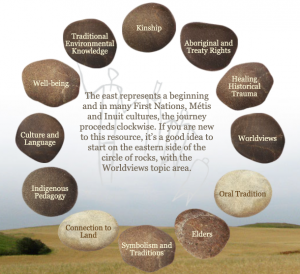Alberta Education created a very comprehensive and interactive guide called Walking Together that provides educators with the necessary resources needed to incorporate FNMI perspectives into the curriculum.
One of my goals in my final project is to create a teacher self-reflection tool to determine which Indigenous perspectives are addressed in a particular lesson. The self-reflection tool would be a circle, similar to the front page of Walking Together, with the perspectives around the outside divided into pie pieces and then specific keywords underneath each perspective, to help guide the teacher in really analyzing their lessons.
I think this resource could also be used as a student activity, perhaps with the student reflecting on how the participation in the activity aligned with Indigenous perspectives. The student version would have student friendly language and offer sentence starter prompts for each perspective/keyword.
However, before introducing this self-reflection tool, students and teachers would both need to have an awareness of Indigenous knowledge and these various perspectives before the tool would be used meaningfully. I plan on creating an interactive multimodal game where these perspectives will be explored as a part of my final project.
